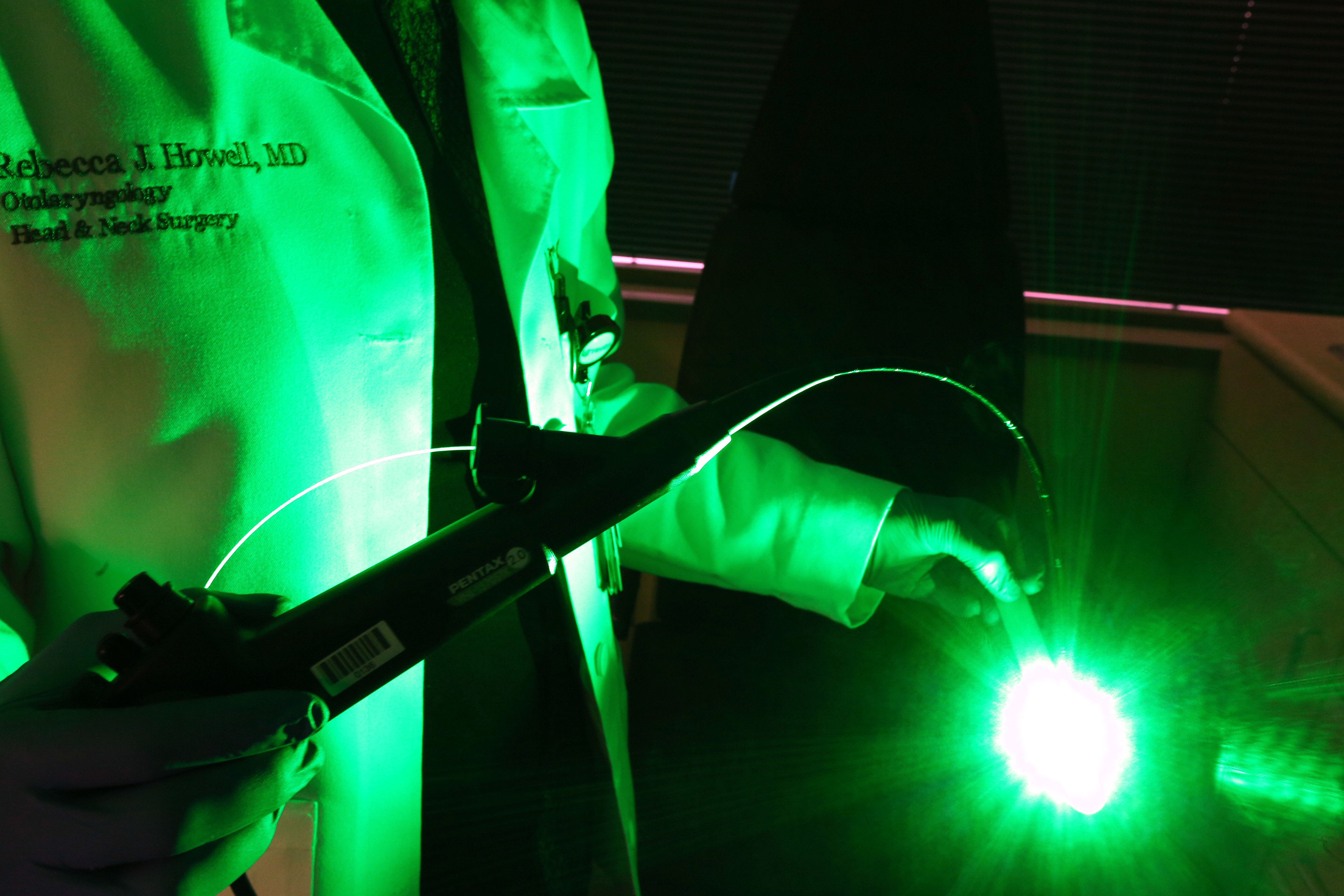Office-Based Laser Treatment of Recurrent Respiratory Papillomatosis Beneficial for Most Patients
In-office laser treatments for conditions such as recurrent respiratory papillomatosis (RRP) “offer patients a very time-efficient alternative to surgery,” said Rebecca J. Howell, MD, associate director of the UC Health Voice and Swallowing Center located at the University of Cincinnati Medical Center in Ohio. Dr. Howell performs the in-office treatment of RRP, a chronic viral disease characterized by the proliferation of benign squamous papilloma within the aerodigestive tract and affects both children and adults, as an alternative to the more common surgical microlaryngoscopy. Both treatments are effective therapies for RRP, and each has its distinct advantages.

Rebecca Howell, MD, demonstrates the use of the 532-nm potassium titanyl phosphate, solid-state (KTP) laser used for the treatment of recurrent respiratory papillomatosis (RRP). The green light is absorbed by the red chromophore in oxyhemoglobin. Image courtesy of University of Cincinnati Medical Center.
Dr. Howell performs several in-office treatments of RRP each month for existing and new patients. Patients, insurers, and surgeons find this therapy “very cost-effective,” she said. Office-based therapies for RRP address certain limitations of operative microlaryngoscopy, including improved patient quality of life and the maintenance of a consistent voice. Because office-based procedures for RRP lessen dependence on general anesthesia, they reduce the OR-associated risks of performing papilloma excision. The 532-nm potassium titanyl phosphate, solid-state (KTP) laser is absorbed by the red chromophore in oxyhemoglobin. Its pulse-length allows for consistent intravascular coagulation and reduces bleeding damage to surrounding epithelium.
In determining if a patient is a good candidate for in-office RRP treatment, Dr. Howell agreed with the Motz criteria, physicians should assess:
– a patient’s anxiety and sensitivity to diagnostic flexible laryngoscopy
– a patient’s potential sensitivity towards a gag reflex
– if an un-sedated laryngeal procedure can be tolerated by a patient
– if a patient has the necessary adequate nasal passage to accommodate a larger channeled endoscope and/or be able to open their mouth sufficiently so instrumentation can be manipulated.1
Dr. Howell also discussed research by Lindsay Madden, MD, that evaluated the role of hemodynamic factors, such as blood pressure and heart rate, in assessing candidates for in-office laryngeal procedures.2 In treating dysplasia and carcinoma patients with cardiac risk factors, Dr. Howell states, “I’d rather treat these patients in-office because general anesthesia presents a different set of risks given a compromised cardiac output.” In her experience, most of her patients, including those with cardiac complications, have excellent effects, but all of them have had safe outcomes. While papilloma patients tend to undergo more procedures due to the nature of the disease, Dr. Howell said that they overwhelmingly preferred the option for more frequent in-office treatments with reduced down time over the surgical microlaryngoscopy. The exceptions are pediatric patients, who are surgically treated because “it is difficult to keep a child awake during in-office procedures.” Occasionally, an in-office procedure can be an important stop-gap treatment. Dr. Howell discussed a pregnant patient in her third trimester who was nearly aphonic. Because of her pregnancy, anesthesia was too risky; the KTP treatment allowed her to become functional through the rest of her pregnancy and her lesion was addressed surgically post-pregnancy.
UC Health’s University of Cincinnati Medical Center’s Voice and Swallowing Center is often one of the first to bring new treatments and practices to the Ohio, Kentucky and Indiana Tri-State areas. “We are pushing boundaries of in-office procedures by treating patients who are not good candidates for anesthesia,” Dr. Howell said. Overall, “in-office laser procedures are an excellent option for patients. At UC Medical Center we are among the few regional and national referral centers for in-office treatment of papilloma. The treatments have long been described in literature as efficacious and safe, and offer an improved patient experience.”
Dr. Howell is currently accepting new patients; to refer a patient please email howellrb@ucmail.uc.edu.
References
1. Motz KM, Hillel AT. Office-based management of recurrent respiratory papilloma. Curr Otorhinolaryngol Rep. 2016;4(2):90-98.
2. Madden L. Hemodynamic changes associated with transcervical laryngeal injection of botulinum toxin. Combined Otolaryngology Spring Meetings, April 26-30, 2017. San Diego, California. Poster.
 Rebecca J. Howell, MD
Rebecca J. Howell, MD
Assistant Professor of Otolaryngology
Associate Director, UC Health Voice and Swallowing Center
howellrb@ucmail.uc.edu
(513) 475-8400
UCHealth.com
Connect with Dr. Howell on Doximity
Leave a reply →
